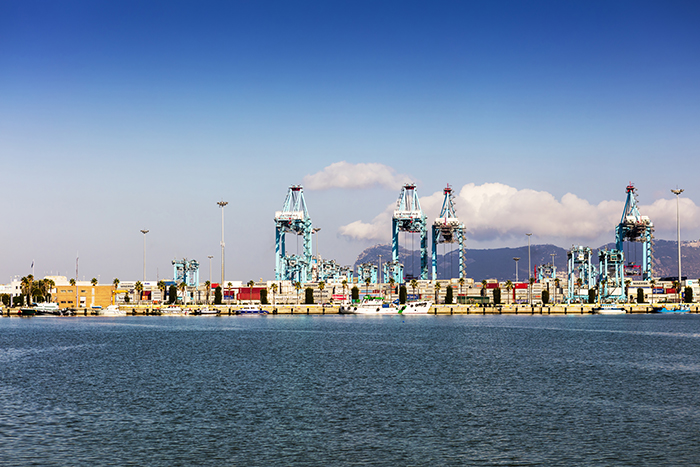Algeria approves deep-sea port
Turloch Mooney, Senior Editor, Global Ports | Feb 03, 2017 12:26PM EST

The Port of Algeciras will soon have new competition.
The government of Algeria has reportedly approved construction of a new deep-sea port 80 kilometers (50 miles) west of the capital Algiers to be financed with loans from China and the African Development Bank, or AfDB.
Plans for the facility at El Hamdania were drawn up in December by Algeria’s Laboratoire des Etudes Maritimes with South Korea’s Yooshin engineering corporation. The total cost of the project is expected to be around $3.3 billion.
The plans consist of a 23-berth facility with a 20-meter (66-foot) alongside draft and eventual capacity of up to 27 million-tonnes-per-annum. Two industrial zones covering 2,000 hectares (4,942 acres) are to be built next to the new port.
China Harbour Engineering and China State Construction Engineering have been linked to the project and local media said the two Chinese state companies will take a 49 percent stake while the controlling stake will be held by the Algerian Port Authority.
The reports said financing will be provided by a consortium of Chinese banks together with funds from a newly secured loan from AfDB.
The AfDB signed an agreement with Algeria at the end of 2016 for a $900 million loan facility. At the time, the bank the loan was to support the country’s industrial and energy competitiveness and “to offset the drop in its revenue due to the sharp fall in oil prices”.
Oil and gas accounts for over 90 percent of Algeria’s export revenues and the low oil price has hit state finances hard. This has led the government to put more focus on measures to diversify the country’s economic base.
“The decline in the price of oil has created a lot of difficulties for many oil exporting countries, and has had an impact on their balances of payment and budgets,” said Kapil Kapoor, an acting vice president with the bank.
Construction work on the new port is scheduled to begin in March and the first berths are due to be operational by 2021.
When operational, the facility is expected to compete for transshipment traffic with Morocco’s Tanger Med port and southern European ports such as Algeciras in Spain and Gioia Tauro in Italy.
A concurrent project to upgrade a highway linking El Hamdania to Algeria’s southern border would also enable the port to complete with West African ports to serve landlocked countries in the region.
Contact Turloch Mooney at turloch.mooney@ihsmarkit.com and follow him on Twitter: @TurlochMooney.
A version of this story also appeared on IHS Fairplay, a sister product of JOC.com within IHS Markit.
Algeria approves deep-sea port
Turloch Mooney, Senior Editor, Global Ports | Feb 03, 2017 12:26PM EST

The Port of Algeciras will soon have new competition.
The government of Algeria has reportedly approved construction of a new deep-sea port 80 kilometers (50 miles) west of the capital Algiers to be financed with loans from China and the African Development Bank, or AfDB.
Plans for the facility at El Hamdania were drawn up in December by Algeria’s Laboratoire des Etudes Maritimes with South Korea’s Yooshin engineering corporation. The total cost of the project is expected to be around $3.3 billion.
The plans consist of a 23-berth facility with a 20-meter (66-foot) alongside draft and eventual capacity of up to 27 million-tonnes-per-annum. Two industrial zones covering 2,000 hectares (4,942 acres) are to be built next to the new port.
China Harbour Engineering and China State Construction Engineering have been linked to the project and local media said the two Chinese state companies will take a 49 percent stake while the controlling stake will be held by the Algerian Port Authority.
The reports said financing will be provided by a consortium of Chinese banks together with funds from a newly secured loan from AfDB.
The AfDB signed an agreement with Algeria at the end of 2016 for a $900 million loan facility. At the time, the bank the loan was to support the country’s industrial and energy competitiveness and “to offset the drop in its revenue due to the sharp fall in oil prices”.
Oil and gas accounts for over 90 percent of Algeria’s export revenues and the low oil price has hit state finances hard. This has led the government to put more focus on measures to diversify the country’s economic base.
“The decline in the price of oil has created a lot of difficulties for many oil exporting countries, and has had an impact on their balances of payment and budgets,” said Kapil Kapoor, an acting vice president with the bank.
Construction work on the new port is scheduled to begin in March and the first berths are due to be operational by 2021.
When operational, the facility is expected to compete for transshipment traffic with Morocco’s Tanger Med port and southern European ports such as Algeciras in Spain and Gioia Tauro in Italy.
A concurrent project to upgrade a highway linking El Hamdania to Algeria’s southern border would also enable the port to complete with West African ports to serve landlocked countries in the region.
Contact Turloch Mooney at turloch.mooney@ihsmarkit.com and follow him on Twitter: @TurlochMooney.
A version of this story also appeared on IHS Fairplay, a sister product of JOC.com within IHS Markit.
Algeria approves deep-sea port








 how does it rank as far as economic growth influence etc
how does it rank as far as economic growth influence etc 
